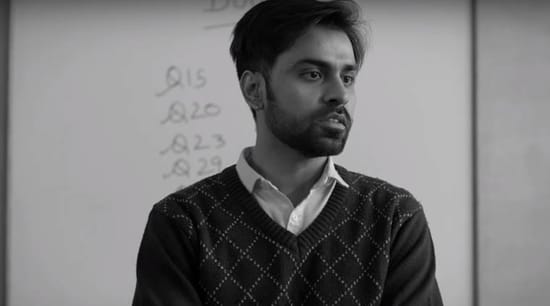A teacher sits down with a student early on at Kota Factory to tell him about the city. The renowned teacher, Jeetu bhaiya (a great Jeetendra Kumar), informs a wide-eyed Vaibhav Pandey, “Students leave Kota in two years, but the place does not leave them for years” (Mayur More).

The statement may sound like a repetition of a typical motivational speech — emphasising the city’s splendour and its capacity to stay with pupils for a long time — but the gripping monologue highlights the city’s hellish nature. To come to Kota, one must leave everything behind, and the place secludes and isolates them.
“The place separates you from the rest, and everything else fades away,” the teacher continues, emphasising how the environment shapes the kids’ personalities.
The five-part series, directed by Saurabh Khanna, begins with a bird’s-eye view of the metropolis. The frame quickly fades to a sepia tone, presumably implying the place’s and its inhabitants’ soullessness.
Over the years, Kota has earned the fabled distinction of producing IIT-ians with breakneck speed. It engages in an unrestrained celebration of the victors, with faces of toppers emblazoned on gigantic billboards threatening to fill the sky. It’s made for rank holders and leaves little room for those who didn’t make it.
Also read: TVF Bachelors season 2 review
The city’s inherent discriminatory nature also serves as a fitting framework for expressing the sorrow of people compelled to live there. Losers who are actually misfits.
In contrast to life, art is kind to losers. In order to avoid treating them as inept, literature and movies frequently romanticise their flaws, exalt them as aspirational, and give them the identity of misfits or underdogs. Their downfall, struggle, and defiance make for a far more compelling storey than those who were expected to succeed.
The refusal to convey their tale is what makes Kota Factory an interesting, entertaining, and vital contribution to the long line of cinematic representations of such “losers.” They exist only in their absence, since the series focuses on individuals who fall somewhere between the rank holders and the rebels: a subset of seemingly ordinary people who live lives so mundane that they don’t have a tale to tell. Their fight is to stay in the storey, not to stray or overtake it.
Students at the Prodigy Institute, Vaibhav and his friends, struggle with the course, not the system. The city’s factory-like appearance does not deter them, nor does the notion of joining a swarm of hundreds of faceless aspirants appear disgusting.
Their disenchantment grows as the series progresses, but it has less to do with the setting and more to do with themselves. Their inability to keep up with the demanding course and consume the tasteless food at the canteen is blamed on them rather than on the institution.
They are more concerned with internal conflicts than with ideological battles, and they do not expect the system to change for them; instead, they seek to alter themselves in order to fit into the system. When they are unsatisfied with the power system, they try to change it without having any desire to change or upset it.
Also read: ‘Outer Banks’ Review
The conformists in the series, Vaibhav, Meena, and Uday, stand on varied degrees of compliance with the administration, have disparate personal objectives, but are united in their tangible ordinariness. Vaibhav appears in one of the series’ episodes, sullen and fatigued after a long day of solving papers.
The latter gives him a book of stories to read in the hopes of keeping him awake. Vaibhav is observed snoring while clutching the book a few minutes later. Though brief, the episode is instructive in that it recognises Vaibhav’s developing irritability as exhaustion rather than discontent. He is not a secret romantic disenchanted with his surroundings; rather, he is a sleep-deprived IIT aspirant.
Kota Factory’s brilliance rests in its capacity to smoothly weave together multiple storey strands. The series provides an evocative image of the dynamics of the place, the city’s proclivity to commodify pupils and discard some as damaged goods, by studying the place through the eyes of students who are precariously positioned between overachievers and underachievers.
At the same time, the students’ interactions in terms of friendship and rivalry subtly reveal how a place that thrives on — and has made a business out of — pitting one student against another also serves as an unlikely meeting point for students from various backgrounds, and in some ways a leveller.
“Tum ameer log kisi bhi din cake kha lete ho kya?” the former bemoans when told it isn’t his birthday. (Do you have cake every day, you affluent people?)
The superb performances, particularly of Ranjan Raj as Meena and Mayur More as Vaibhav, add a lot to the five-episode series. It gives an affecting representation of a protagonist going through his rite of passage in numerous ways.
It also gives a glimpse into the lives of those whose lives are too commonplace to be written about, educates about the many friendships formed in these seemingly hostile organisations, and demonstrates how, when those friends go their separate ways, a commitment to meet again is extracted. There is no mention of the location. People in Kota want to find themselves in familiar surroundings.